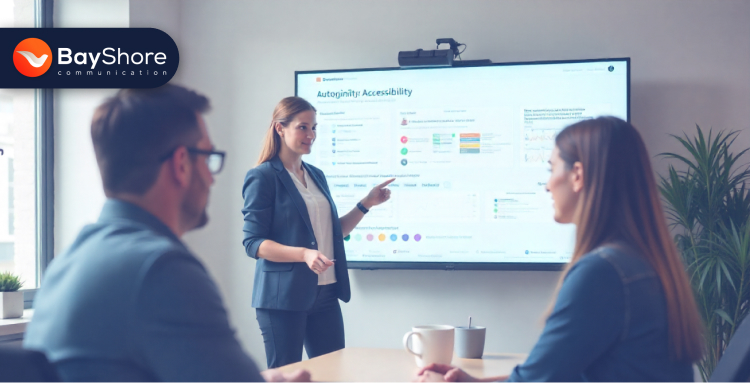
The internet in the United States moves faster and touches more parts of life than ever, powering e-commerce, healthcare, education, and government services. Yet, for millions of Americans living with disabilities, websites remain confusing, frustrating, or completely unusable. Accessibility is no longer just a checkbox on a compliance list, it is a business-critical strategy that determines who can engage with your brand and who is left out.
Bayshore Communication helps U.S. businesses turn digital barriers into opportunities, creating websites that are ADA compliant, sleek, intuitive, and welcoming to all users. The question is, are your digital experiences truly inclusive, or could your website be silently pushing away thousands of potential customers without you even realizing it
Accessibility is no longer optional for American businesses. The legal outlook has shifted, with the Americans with Disabilities Act (ADA) and Section 508 increasingly shaping digital compliance standards. Lawsuits against inaccessible websites are growing each year, showing that ignoring accessibility carries tangible financial and reputational risks.
At the same time, accessibility opens doors to a significant audience. According to the CDC, over 61 million Americans live with a disability, representing a substantial portion of consumers with buying power.
How Bayshore helps:
Conducting compliance audits to identify potential gaps before they become legal or financial problems.
Advising businesses on practical design strategies that satisfy legal requirements while enhancing usability.
Educating teams on long-term accessibility planning so websites stay functional and inclusive as they evolve.
Understanding these numbers makes it clear that inclusive design is both a responsibility and a business advantage.

Accessibility affects real people in tangible ways. Small design oversights can prevent users from accessing critical information, creating frustration and exclusion. Bayshore Communication addresses these challenges by focusing on human-centered solutions:
Incorporating user feedback from people with diverse abilities
Bayshore actively tests websites with users who rely on screen readers, voice navigation, or other assistive technologies. An educational platform discovered that interactive charts were inaccessible for students using screen readers. Bayshore redesigned them with descriptive tables and audio labels, allowing students to complete assignments independently and without assistance. By grounding design decisions in real user experience, accessibility becomes practical, meaningful, and effective.
Ensuring features such as screen reader compatibility, keyboard navigation, and readable layouts are standard
Accessibility is embedded into every project rather than added as an afterthought. A healthcare website, for example, needed patients to book appointments efficiently. Clear labeling, logical form structures, and full keyboard navigation reduced errors and made online scheduling straightforward. These improvements benefit all users, enhancing usability and overall satisfaction.
Designing experiences that anticipate user needs before issues arise
Bayshore takes a proactive approach to prevent obstacles. An e-commerce company needed product filters usable by visually impaired shoppers. Bayshore implemented accessible filters with text labels and logical tab order, enabling smooth navigation and shopping. Anticipating potential barriers ensures websites remain inclusive even as content evolves, making accessibility an integrated part of the user experience.
Reducing cognitive load through predictable layouts and clear navigation
Websites that follow consistent visual hierarchies and labeling help users with cognitive differences process information efficiently. Bayshore restructures complex pages into logical flows so visitors can easily complete tasks or locate content. This improves engagement, satisfaction, and confidence in using the website.
Making accessibility a long-term habit, not a one-time fix
Accessibility is an ongoing process. Bayshore trains client teams to maintain standards as new pages, content, and features are added. A financial services client reported a significant drop in customer support calls after implementing Bayshore’s guidance, demonstrating how accessible design reduces friction and empowers users.
By focusing on these strategies, Bayshore Communication shows that accessibility is more than compliance. It creates digital spaces where users feel included, capable, and respected, transforming websites into meaningful, inclusive experiences that strengthen engagement and trust.
Accessible web design relies on four main principles that make websites usable and inclusive. When applied thoughtfully, these principles transform digital spaces so all users can engage seamlessly
Perceivable: Content must be visible and understandable for everyone. Images need alt text, videos need captions, and typography should be easy to read. Bayshore Communication ensures these elements are standard. An online retail client improved engagement after alt text allowed screen reader users to navigate products independently
Operable: Navigation must work for every user, regardless of how they interact with the site. Keyboards, voice commands, and assistive devices must be supported. Bayshore redesigned a healthcare platform so patients could book appointments using only a keyboard. Completion times improved and errors decreased, showing smoother experiences for all.
Understandable: Content and interfaces should be clear and predictable. Labels, menus, and error messages guide users rather than confuse them. A student registering for an online course received clear instructions if a form field was incomplete, reducing frustration and cognitive load.
Robust: Websites must remain compatible with new browsers, devices, and assistive technologies. Bayshore tested a financial dashboard across platforms to ensure consistent performance. Robust design protects the website as technology evolves and ensures all users can access information
Bayshore Communication applies these principles throughout design and development. We provide teams with guidance to maintain accessibility as sites grow. Following these principles creates digital experiences that are inclusive, functional, and engaging while building trust with users
Bayshore’s integration:
Embedding these principles into every stage of design and development.
Offering guidance to ensure accessibility remains a priority rather than an afterthought.
Following these principles allows businesses to create digital experiences that are inclusive, functional, and engaging.

Creating a fully accessible website is not just about checking boxes. Bayshore Communication combines technology, strategy, and design expertise to deliver websites that meet ADA standards while remaining visually appealing.
Implementation examples:
Conducting accessibility audits using tools like WAVE and axe to pinpoint issues early.
Integrating accessibility from wireframes to prototypes, avoiding costly redesigns later.
Testing websites with real assistive technologies, including screen readers and voice navigation.
Updating and refining websites continuously to accommodate new content and technological changes.
A survey from the American Chiropractic Association found that 92% of Americans working from home report new or increased back, neck, or shoulder pain, highlighting how digital experiences can impact everyday usability and wellness. Bayshore applies the same attention to user comfort, ensuring accessibility improves engagement and satisfaction.
Accessible websites do more than comply with regulations. They expand market reach, strengthen brand trust, and improve user engagement. Clear layouts, consistent navigation, and optimized content also help search engines index sites more effectively, providing an indirect boost to visibility.
Retail websites serving more customers
A retail site that incorporates features such as voice search, alt text for product images, and keyboard-friendly navigation allows a wider range of customers to shop independently. Bayshore Communication worked with a mid-sized apparel brand to make its product catalog accessible, which increased online purchases from users with disabilities and reduced support inquiries from all shoppers.
Government and healthcare portals improving completion rates
Clear, accessible forms prevent errors and frustration for all users. A city government portal redesigned its utility payment forms with guidance from Bayshore, adding logical tab orders, clear labels, and screen reader compatibility. As a result, form submission errors dropped by nearly 30 percent, reducing call center traffic and improving overall efficiency.
Education platforms enhancing participation
Online learning platforms that provide accessible video content, interactive elements, and readable materials reach more students, including those with disabilities. Bayshore helped a university course portal implement captions, transcripts, and structured navigation. Students who previously struggled with enrollment or content access reported smoother experiences, demonstrating how accessibility directly impacts engagement and retention.
Corporate websites building brand trust
Businesses that prioritize accessibility signal inclusivity and social responsibility. As reported by The Economist, companies embracing accessibility see stronger customer loyalty and long-term engagement. A corporate consulting firm worked with Bayshore to redesign its client portal with readable dashboards, alt text, and keyboard navigation. Clients reported increased confidence in using the platform, which enhanced the firm’s reputation for user-centered service.
Driving innovation across industries
Accessibility improvements often lead to innovations that benefit all users. For example, a travel booking platform implemented predictive text, voice-assisted navigation, and accessible filters with Bayshore’s support. These enhancements helped users with disabilities and sped up booking for all travelers.
Bayshore Communication ensures that every website we build is welcoming, functional, and effective for all visitors. Accessibility becomes not just a compliance measure, but a growth opportunity that enhances engagement, builds trust, and strengthens the business in a competitive market

Bayshore Communication combines U.S.-based expertise, design creativity, and technical know-how to make every website accessible and functional. Our team works across healthcare, education, retail, and finance, ensuring inclusivity becomes a strategic advantage.
What sets Bayshore apart:
Accessibility is incorporated from the first wireframe to website launch.
Teams receive training to maintain compliance as websites grow.
Design solutions are crafted to satisfy both accessibility regulations and user expectations.
By prioritizing accessibility, Bayshore Communication helps businesses expand our audience, build trust, and future-proof their digital presence. So, contact us and see how your website can become a space where everyone feels welcome and able to participate